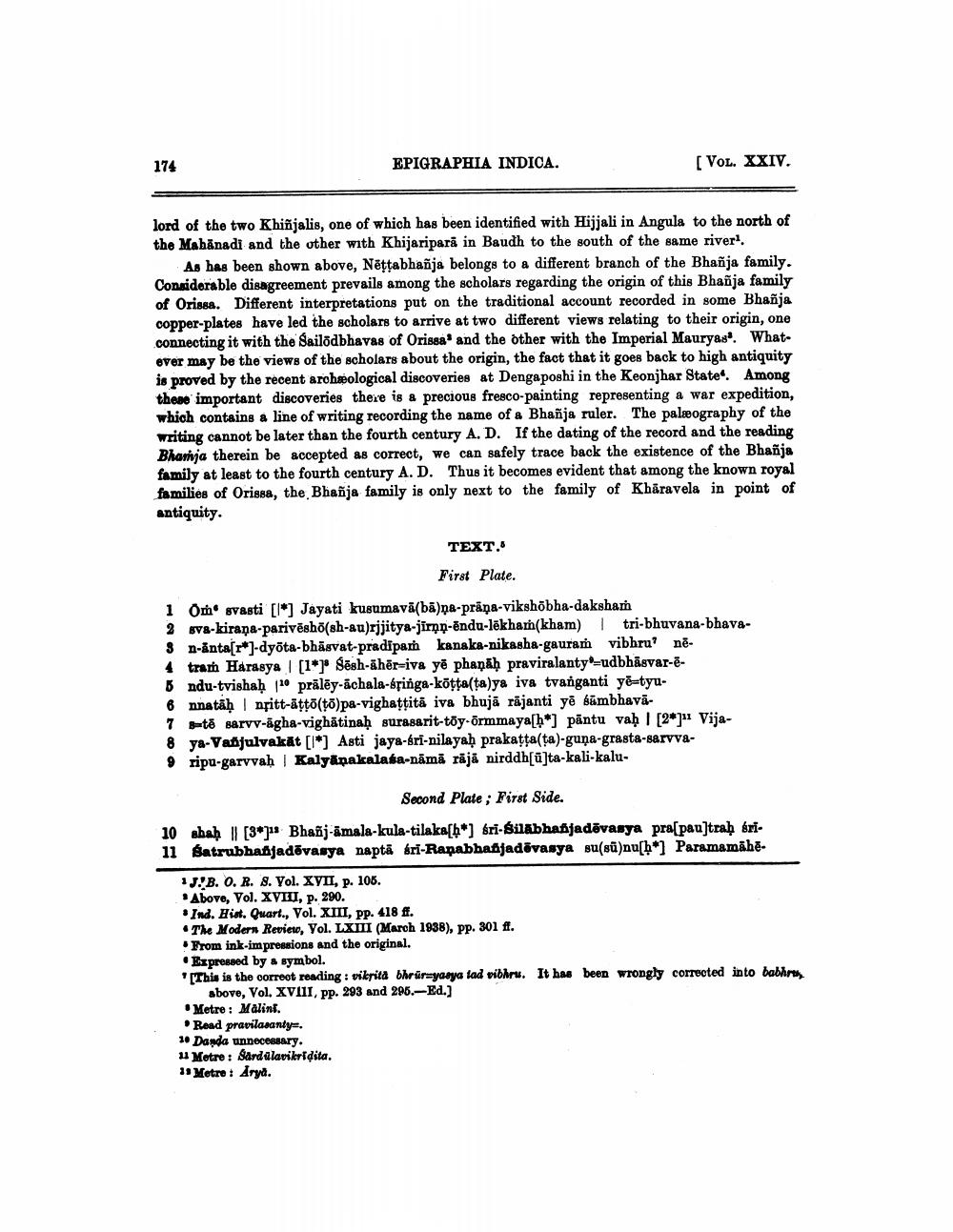________________
174
EPIGRAPHIA INDICA.
lord of the two Khiñjalis, one of which has been identified with Hijjali in Angula to the north of the Mahanadi and the other with Khijaripara in Baudh to the south of the same river1.
As has been shown above, Neṭṭabhañja belongs to a different branch of the Bhañja family. Considerable disagreement prevails among the scholars regarding the origin of this Bhañja family of Orissa. Different interpretations put on the traditional account recorded in some Bhanja copper-plates have led the scholars to arrive at two different views relating to their origin, one connecting it with the Sailōdbhavas of Orissa and the other with the Imperial Mauryas. Whatever may be the views of the scholars about the origin, the fact that it goes back to high antiquity is proved by the recent archeological discoveries at Dengaposhi in the Keonjhar State. Among these important discoveries there is a precious fresco-painting representing a war expedition, which contains a line of writing recording the name of a Bhañja ruler. The paleography of the writing cannot be later than the fourth century A. D. If the dating of the record and the reading Bhamja therein be accepted as correct, we can safely trace back the existence of the Bhanja family at least to the fourth century A. D. Thus it becomes evident that among the known royal families of Orissa, the Bhañja family is only next to the family of Kharavela in point of antiquity.
TEXT.'
[VOL. XXIV.
First Plate.
1 Om svasti [*] Jayati kusumavā(bā)pa-prāņa-vikshōbha-daksham
2 sva-kirana-parivesho(sh-au)rjjitya-jirnn-endu-lēkham(kham) | tri-bhuvana-bhava
3 n-anta[r]-dyota-bhasvat-pradipam kanaka-nikasha-gauram vibhru nē.
4 tram Harasya [1] Sesh-äher-iva ye phaṇaḥ praviralanty*-udbhāsvar-e
5 ndu-tvishaḥ 10 präley-achala-éringa-kōṭṭa(ta)ya iva tvanganti ye-tyu
6 nnataḥ nritt-aṭṭo(to)pa-vighaṭṭita iva bhuja rajanti yē sambhava
7 ste sarvv-agha-vighātinaḥ surasarit-toy-ormmaya[h*] pantu vaḥ | [2] Vija
8 ya-Vañjulvakat [*] Asti jaya-sri-nilayah prakaṭṭa(ta)-guna-grasta-sarvva
9 ripu-garvvah Kalyanakalasa-nāmā rājā nirddh[u]ta-kali-kalu
Second Plate; First Side.
10 ahab [3] Bhañj-amala-kula-tilaka[*] śri-Biläbhañjadēvasya pra[pau]traḥ śri11 Satrubhanjadēvasya napta śri-Ranabhañjadēvasya su(sü)nu[*] Paramamahē
1JB. O. R. 8. Vol. XVII, p. 105.
Above, Vol. XVIII, p. 290.
Ind. Hist. Quart., Vol. XIII, pp. 418 ff.
The Modern Review, Vol. LXIII (March 1938), pp. 301 ff.
Read pravilasanty=.
10 Daşda unnecessary.
11 Metre: Sardalavikriḍita.
13 Metre: Arya.
From ink-impressions and the original.
Expressed by a symbol.
[This is the correot reading: vikrita bhrüryasya tad vibhru. It has been wrongly corrected into babhru, above, Vol. XVIII, pp. 293 and 295.-Ed.]
Metre: Malini.




